





For the purposes of this article, we will only look at cold hardy goldfish varieties that can be kept outside year round in a water garden setting. All of these goldfish live harmoniously with each other and koi.
Common Goldfish
Obviously, the common goldfish is well, very common. Not to say it doesn't have its advantages though, because the common goldfish is a hardy, brightly colored addition for your pond. Common goldfish are a perfect, inexpensive pond inhabitant if you are just starting out and don't want to worry about maintaining expensive, picky fish. Often a dozen or more common goldfish can be bought for just a dollar.
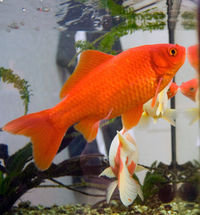 Common Goldfish
Common Goldfish
Common goldfish are distinguishable by their stout bodies, bright orange color, and most importantly, their short tail. As compared to other goldfish, their tails are small, only growing in length about 25% of the body length. Their orange to red scales shimmer when they catch the afternoon sun in the pond and are very easy to see amongst pond plants. They grow very quickly and reproduce even faster. Keep your eye out for fry as soon as your common goldfish are 2 inches or so long.
Comet
Comet goldfish are also very common in the water gardening hobby and can easily be purchased at big box pet stores inexpensively. They are just as hardy as the other goldfish on this list and can survive very cold winter water temperatures.
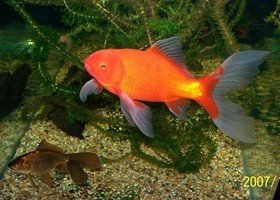 Comet Goldfish - Note the long tail
Comet Goldfish - Note the long tail
Comets can be distinguished from common goldfish by their extra long tails which are deeply forked and pointed at the ends. Comet goldfish most commonly come in reddish-orange, but can also be found with a variety of markings and color combinations of black, white, red, orange, and yellow. They are a very playful and curious type of goldfish and will make an excellent pond pet.
Sarassa (sah RAW sa)
Sarassa are a specific variety of comet goldfish that are characterized by their vivid red markings on a stark white body. Upon first glance in a pond, Sarassas can be mistaken for a small Kohaku koi with their bright red patterning. The body shape of Sarassa is the same as a regular comet, punctuated by the long, attractive tail.
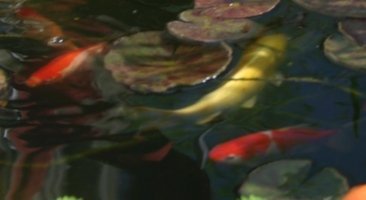
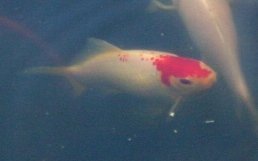 Slight variation between reds in comet (L) and a Sarassa comet (R)
Deep red on white body
Slight variation between reds in comet (L) and a Sarassa comet (R)
Deep red on white body
Shubunkin (shah BUNK in)
Also known as calico goldfish, Shubunkinsmight be the most varied of all goldfish varieties. Shubunkins' only standard feature is their diverse coloration that can include red, orange, brown, and yellow patches punctuated by black dots of varying sizes. The patterning extends through the fishes' long and graceful tails. Shubunkin scales are clear so to the eye the fish look see through; depending on the color underneath, the fish's body can appear blue, violet, pink, or silver.
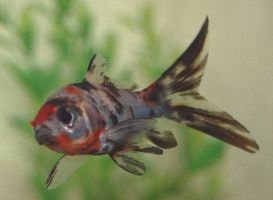
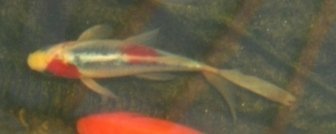
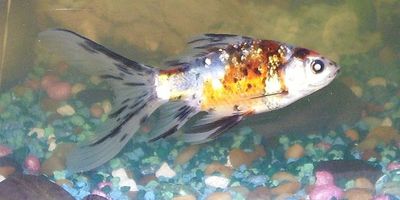 Red splotches with thick black spots
Bluish-silver appearance of body
Orange and brown patches with black spots
Red splotches with thick black spots
Bluish-silver appearance of body
Orange and brown patches with black spots
Shubunkins are considered one of the hardiest of all goldfish due to their disease resistance and temperature fluctuation tolerance. If koi are not an ideal inhabitant of your pond, Shubunkins can supplement the distinctive and varied coloration you desire.
Wakin (WAH keen)
Wakin are very common goldfish in Japan and are making a surge in North America recently. Their body shape is rounded and somewhat strange when viewed from the side. The real pleasure of Wakins is their double tail that looks like a pompom skirting around the pond when viewed from above. They are hardy and healthy fish that take to many different environments easily. Wakins come in an assortment of patterns in red and white. As they age, their red hue gets darker as with koi. Pure red and pure white Wakins are also available.
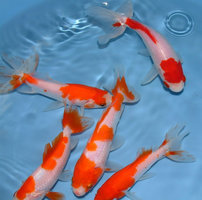
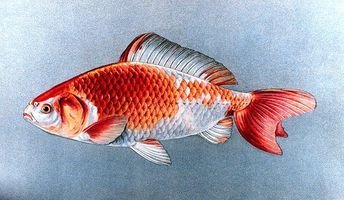 Double tail from top-view
Rounded body shape from side-view
Double tail from top-view
Rounded body shape from side-view
The name Wakin means "Japanese goldfish" in Japanese. They are not so common stateside that they are easy to find, but as their popularity grows their availability will increase.
Tamasaba
Tamasaba goldfish are a newer introduction to North American ponds from Japan. Their availability is very limited as is information on this kind of fish. Their bodies resemble a bulbous Ryukin goldfish with the added benefit of cold hardiness. When viewed from above, Tamasabas look short and stout with a single, long tail; though when viewed from the side, a large protruding belly is revealed. Hopefully in the near future these interesting fish will be more available to hobby water gardeners. In the meantime you can see pictures of them here.
Goldfish are inexpensive, beautiful, and varied creatures to add to your water garden. If you have filtration in your pond and a desire to have a few extra inhabitants, why don't you try one of these special goldfish varieties. Fish and snails are available from mail order suppliers if your local stores have limited selections. Happy ponding!
:::::
Photo credits:
Wakin Group - Ian John of Backyardpuddle.com All other images were found on Wikipedia Commons Thumbnail, silver bodied Shubunkin, red headed comet, and comet, Sarassa and yellow koi - Susanne TalbertSources:
http://en.wikipedia.org/wiki/Comet_(goldfish)
http://www.aquaticcommunity.com/goldfish/shubunkin.php
http://www.wakin.us/
http://www.backyardpuddle.com/
Best Landscaping Tips For Utah Residents
Dutch Gardening, For The Informal Gardener
Tips For Growing A Successful Organic Garden
The Most Popular Outdoor Water Features Trends For 2015
5 Tips For Finding The Perfect Place For Your Garden Water Fountain
Halloween Garden Décor: Tips For Halloween Decorating In The Garden
Copyright © www.100flowers.win Botanic Garden All Rights Reserved